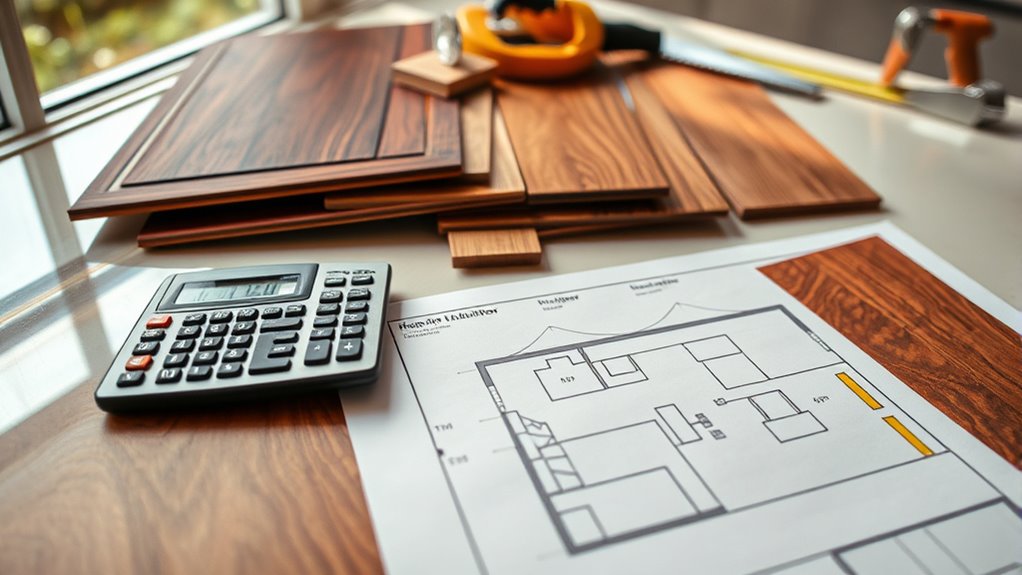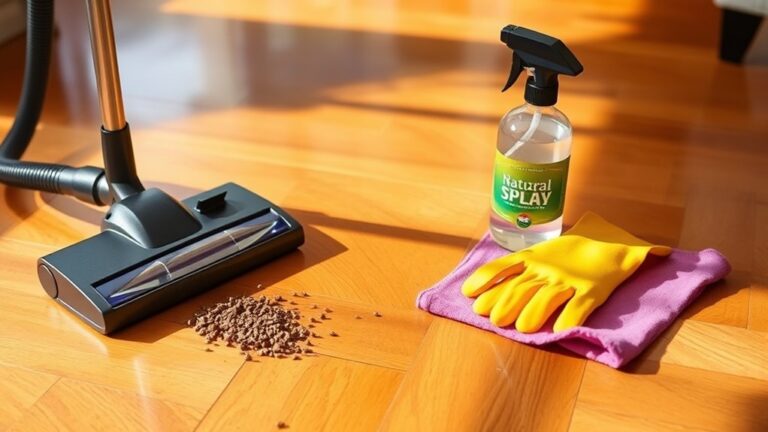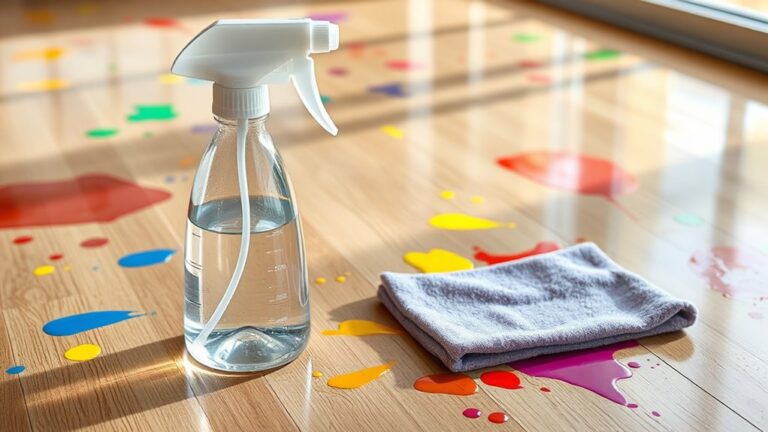When installing hardwood floors, five key factors affect your costs: the hardwood species and grade you choose, which affect both price and durability; the size and layout of your space, since larger or complex rooms take more materials and labor; the condition of your subfloor, as repairs and moisture control add expenses; your installation method and labor rates; plus extra materials like underlayment and finishing. Understanding these elements helps you budget wisely—explore each to optimize your investment.
Type and Quality of Hardwood Material

When choosing hardwood flooring, the type and quality of the material greatly impact both cost and durability. You’ll find hardwood species vary widely—from oak and maple to exotic options like Brazilian cherry—each with distinct hardness and appearance. Hardwood species influence not only aesthetics but also resilience against wear and tear. Flooring grades further affect price and stability; clear grade offers minimal knots and blemishes, ideal for a flawless finish, while select and common grades allow more natural character but may cost less. Understanding these parameters lets you balance upfront investment with long-term satisfaction. By selecting the right hardwood species and appropriate flooring grades, you gain control over durability and visual appeal, ensuring your flooring choice complements your lifestyle and freedom to personalize your space.
Size and Layout of the Installation Area
The size and layout of your installation area directly affect the overall cost and complexity of hardwood flooring projects. When evaluating your room dimensions and Boden plan, larger spaces naturally require more materials and labor, increasing expenses. Complex layouts with multiple corners, angles, or irregular shapes add to installation time and difficulty, impacting cost.
Consider these factors:
- Total square footage based on accurate room dimensions
- Number of doorways and connections between rooms
- Presence of alcoves, closets, or non-standard shapes in the floor plan
- Accessibility and clearance around the installation space
Preparation and Subfloor Conditions
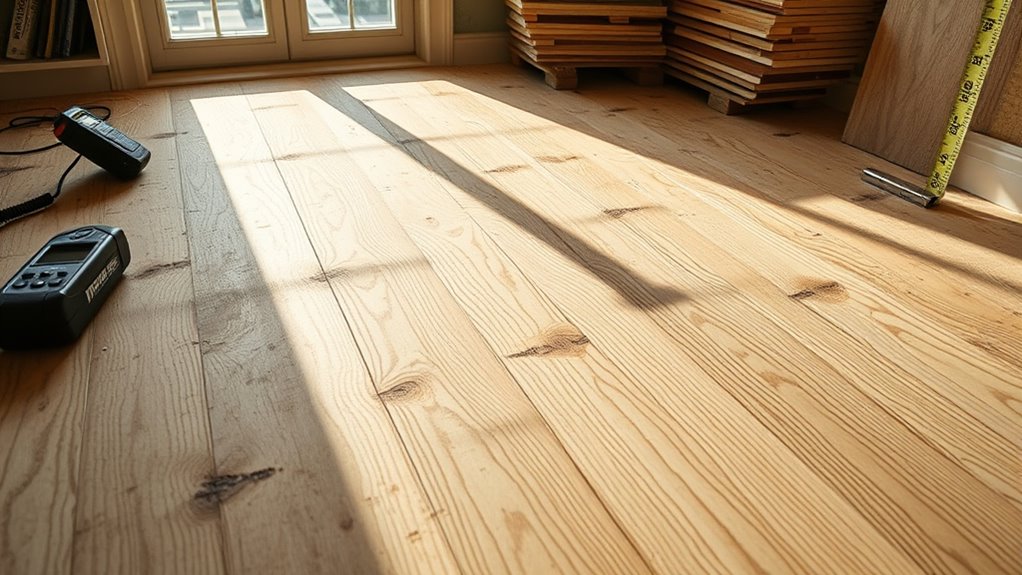
Once you’ve assessed the size and layout of your installation area, attention turns to preparation and subfloor conditions. A thorough subfloor assessment is essential before installing hardwood flooring. You’ll need to check for levelness, structural integrity, and cleanliness. Uneven or damaged subfloors may require repairs or additional materials, impacting your overall cost. Moisture testing is equally critical; excess moisture can cause hardwood to warp or buckle over time. Using a reliable moisture meter, you can measure subfloor moisture content to guarantee it falls within acceptable limits, typically below 12%. Addressing any moisture issues before installation protects your investment and prevents costly future repairs. Proper preparation and a sound subfloor create the foundation for a durable, long-lasting hardwood floor, making this step indispensable in your project planning.
Labor and Installation Method
Although you might handle some installation steps yourself, labor costs often represent a significant portion of your hardwood flooring project expenses. The choice of installation techniques directly impacts these costs. For example, nail-down methods typically require more skilled labor, increasing labor costs, while click-lock systems can be faster and less costly to install. Additionally, labor intensity varies with floor complexity and room size. Consider these factors:
Labor costs vary with installation methods, floor complexity, and room size, significantly affecting your hardwood flooring budget.
- Type of installation techniques (nail-down, glue-down, floating)
- Floor pattern complexity (straight, herringbone, diagonal)
- Subfloor condition affecting preparation time
- Installer experience and regional labor rates
Additional Materials and Finishing Costs
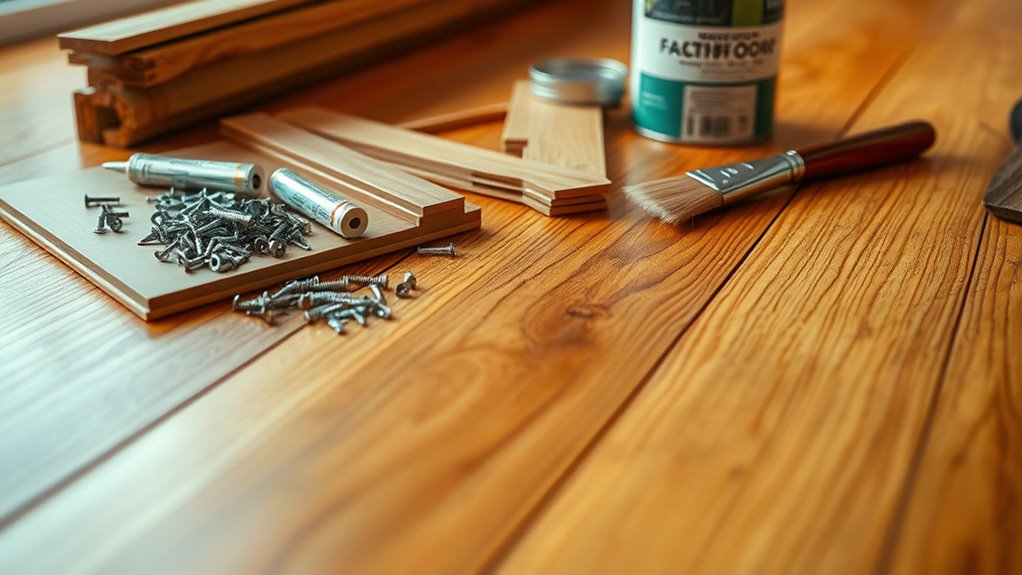
Labor choices and installation methods directly influence your project’s overall budget, but they’re only part of the cost equation. Additional materials like underlayment, adhesives, and trims add to your expenses. Finishing costs—including staining, sealing, and multiple coats of finish—are essential for durability and aesthetics, impacting your total investment.
| Material/Service | Typical Cost Range | Zweck |
|---|---|---|
| Unterlage | $0.50 – $1.50 per sq ft | Moisture barrier, soundproofing |
| Adhesives | $0.30 – $0.70 per sq ft | Secures hardwood in place |
| Trim & Molding | $1.00 – $3.00 per linear ft | Finishes edges and connections |
| Fleck | $1.00 – $3.00 per sq ft | Color customization |
| Finish Coats | $2.00 – $4.00 per sq ft | Protection and longevity |
Budget these carefully to maintain freedom in design and quality.

